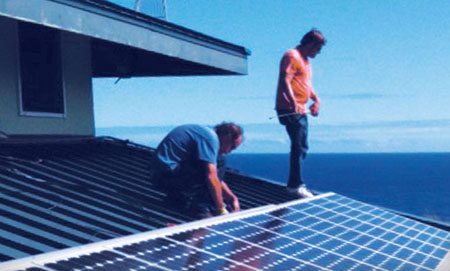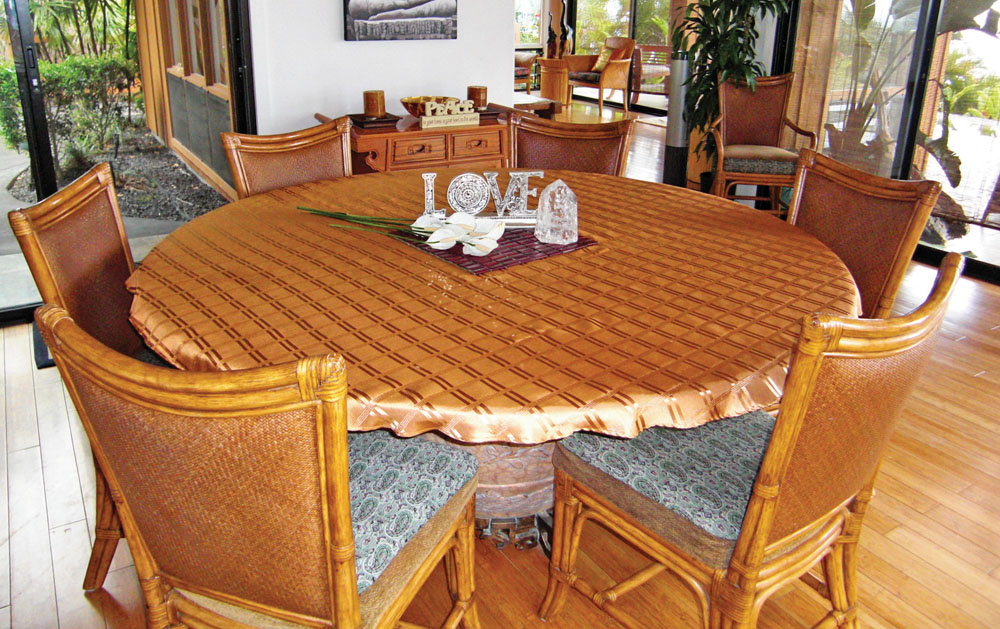
Let There Be Light! There’s Power in Photovoltaics

By Mike Moore

It’s been said that the amount of sunlight that hits the Earth’s surface in one hour is enough to power the entire world for a year. Given that within the next 25 years our world’s energy demands are expected to more than double, it’s about time we started looking up and take advantage of this boundless energy from the sun.
Current technology allows us to effectively harness this renewable energy resource, and local suppliers are saying Hawai‘i is in a boom cycle for PV installations.
Photovoltaics is the direct conversion of light into electricity. Common semi-conductor materials such as silicon are used in solar panels to absorb photons of light and release electrons. These electrons are then directed into a current to supply electricity. An inverter converts the direct current into alternating current, which becomes compatible with our household needs. Panels are combined in arrays that are sized according to our energy demands.
There are three basic types of photovoltaic (PV) electrical systems on the market today:
- Stand-alone, off-grid systems are completely independent of the utility grid, and must have batteries to provide energy storage during times of low input or high usage. A backup generator can be utilized if the available sunlight is inadequate.
- Battery-based, grid-tie systems are connected to the utility grid so they can use utility electricity when needed and send back unused surplus of generated electricity to the grid. Battery storage becomes a backup system in case of a blackout, although this is not possible for an extended length of time.
- Battery-less grid-tie systems are the simplest of all renewable systems, having only the energy generation technology and an inverter connected to the utility grid. Without batteries, there is no backup system in case the grid goes down.
The primary advantage of off-grid systems is complete energy independence. They are not affected by frequent utility company rate increases, blackouts or brownouts. Off-grid systems require energy conservation measures, as every decision that increases your energy demand must be carefully considered. System maintenance, such as battery replacement, tree trimming and troubleshooting skills are often necessary responsibilities. If surplus energy is generated, it is wasted. This is not the case with a grid-tied system that feeds it back to the utility.
 The primary advantage of a grid-tied system is the lower upfront cost, as panels can be added incrementally as finances allow. This is referred to as “scalability.” A major disadvantage is that there is less incentive to conserve, even if the appeal of never receiving a utility bill remains quite tempting.
The primary advantage of a grid-tied system is the lower upfront cost, as panels can be added incrementally as finances allow. This is referred to as “scalability.” A major disadvantage is that there is less incentive to conserve, even if the appeal of never receiving a utility bill remains quite tempting.
Michael Longo of Onomea, who recently installed a grid-tied PV system, says, “Our electric bill has been zeroed out and we even produce a surplus of energy without compromising our everyday usage. This has proven to be a terrific investment, not only financially, but also for our environment.”
How much will a PV system cost? Well, that depends on several variables. Your electrical “appetite” includes the appliances you use and your usage habits. First, it is advisable to lower your overall demand by installing a solar hot water system, Energy Star appliances, propane fixtures, compact fluorescent and LED lighting. A general cost guideline for most systems is about $5.50/watt or $20,000-$30,000 for the average home. A solar professional will assist you in calculating your actual KWh demand. Despite the high entry cost, the popularity of photovoltaic systems continues to grow as financial incentives in the form of State and Federal Tax Credits become more enticing. They are currently at 35 and 30 percent, respectively. In general, the return on investment for a complete PV system is around 14 percent with a 7-9 year payback and a 25-30 year useful life. If you consider where utility rates will more than likely be in the next 10-20 years, the real financial return on investment for the life of the system becomes much more attractive.
PV modules are a commodity and pricing will fluctuate based upon worldwide supply and demand. Right now the industry is experiencing a real “boom-bust” cycle according to local solar expert Louis Valenta of Inter-Island Solar Supply. In his 33 years in the industry, he says he has never seen anything like this, and large commercial installations impact the availability of panels for residential customers. “The market really needs to stabilize to provide customers with locked-in pricing beyond 30 days and more predictable lead times when ordering.” Valenta advises anyone considering a PV system to plan well in advance and allow sufficient time for proper delivery of all necessary components.

As innovations in the technology continue to improve, the price for most components will invariably come down. It is safe to say there is no such optimism for the future price of fossil fuels, which directly impact our utility rates.
Hawai‘i receives great “peak sun hours.” To be cost-effective, you must have unobstructed and unshaded, solar access at your site from the hours of 9 a.m. to 3 p.m. year round. South facing orientation is ideal for the highest efficiency, whether the system is mounted on the roof or on the ground. Sufficient space for a roof mount must be considered, along with the appropriate roof angle (pitch). For flat panel systems, monocrystalline PV cell panels are the best-quality modules available on the market today. Thin film solutions are gaining in popularity and are the fastest growing segment of the technology.
There is no shortage of dealers, distributors and installers of PV systems today, as the technology has gained mainstream acceptance. Be sure that the person designing and installing your PV system has the expertise to make it efficient, safe, and reliable. Don’t be swayed by the lowest price, as experience will pay off in the long run.
As noted by Paul Moore of Solarman, with over 22 years experience in the photovoltaic industry, “We are certainly seeing more and more PV installers coming in every year, which can be a benefit to the customer if the proposed products are equivalent in quality and performance. Healthy competition may drive down the pricing, but you don’t want to cut any corners.”
This is not a project for the do-it-yourselfers, no matter how tempting it is to save a few dollars. Inquire about product warranties from any manufacturer or supplier, as well as ongoing technical support and advice, client references, appropriate PV experience and proper licensing for the solar professional.
Yes, clean and green technology is all the rage, but do your homework, count the cost, and carefully weigh the anticipated benefits. The sun will continue to shine down on us, no matter how long it takes to get our attention. ❖


